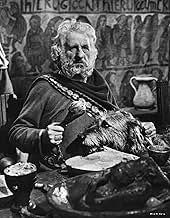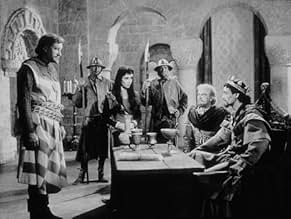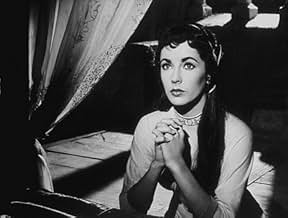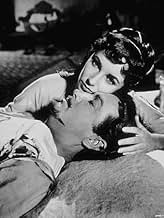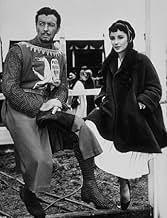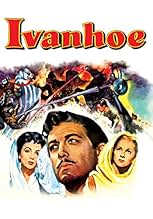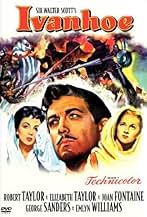AVALIAÇÃO DA IMDb
6,7/10
11 mil
SUA AVALIAÇÃO
Um cavaleiro tenta libertar o cativo Rei Ricardo e colocá-lo de volta no trono.Um cavaleiro tenta libertar o cativo Rei Ricardo e colocá-lo de volta no trono.Um cavaleiro tenta libertar o cativo Rei Ricardo e colocá-lo de volta no trono.
- Direção
- Roteiristas
- Artistas
- Indicado a 3 Oscars
- 2 vitórias e 9 indicações no total
Francis De Wolff
- Front De Boeuf
- (as Francis DeWolff)
Avaliações em destaque
I can't comment on the film as an adaption but I did find that it was quite entertaining standing alone. Some have criticized Robert Taylor for being too stiff, but I found him to be suitably formal and chivalrous. Elizabeth Taylor and Joan Fontaine both provided ample glamour and grace to their roles. They are also both very photogenic to say the least. The performance of George Sanders intrigued me the most. Though a villain, he actually became more sympathetic to me as the movie progressed. The relationship of the four major characters was what kept me interested. Although I am sure it took careful planning and execution (and a lot of extras) to stage the fight scenes, I actually thought they were quite perfunctory. Solid if not spectacular, 7/10.
An engrossing movie about 12th century England. It has everything you would want to see in a movie about medieval Europe: knights, fair maidens, jousting tournaments, battles, and feuding crowns. Yet the movie is not boring in any way. I enjoyed every minute of it. The title character is an Anglo-Saxon knight who's on a mission to return the imprisoned king, Richard the Lionhearted, to his throne. Along the way, Ivanhoe encounters some obstacles that may endanger his own life and threaten the future of England. Everything about this movie is enchanting. The movie is very colorful, the score is outstanding, and it's exciting to watch the battle scenes. I really enjoyed seeing one of my favorite actors, George Sanders, playing yet another villain. It was also great to see the always ravishing Elizabeth Taylor (at a very young age), who plays a jewish maiden. I liked the way the movie demonstrated the persecution of jews living in England at the time, and how they were looked down upon in spite of the different ethnic groups that made up the English population. Above all, I really liked the ending--it was awesome. Interestingly, this movie (which is from 1952) is more entertaining than and not as theatrical as some of the historical dramas that were made AFTER this movie.
Although the story of Ivanhoe has been brought to screen several times, this is the version that I have always considered outstanding. Yes, I admit that it is a free adaptation of Sir Walter Scott's novel, much is changed. I also admit that it is a clearly Hollywood production of the early 1950s with cast elites of the time. Yet, IVANHOE is extremely entertaining as an epic movie.
MIDDLE AGES ON SCREEN: The picture of the medieval England of the 12th century is very appealing. Viewers get a right impression of the lifestyles, believes, and values of the time. And it is not only because of the costumes and sets... the film is supplied with such moments that allow us to travel in our imagination to the distant Middle Ages. I loved the tournament, for instance, when the "knight with the hidden face" (Ivanhoe) is supposed to prove his courage. Here, a mention must also be made of the castle siege and the very natural action. Another important medieval aspect that is developed in the film is man's chivalric love to a woman. Ivanhoe comes back to his homeland and refers to the vows of chastity he has made with his beloved Lady Rowena (Joan Fontaine). This delicacy combined with straightforward love and courage with sacrifice are very beautiful...and very medieval (consider this aspect in Gibson's BRAVEHEART as well). Finally, funny moments are accurately embedded in the context. The scenes with humble Squire Wamba (Emlyn Williams) constitute the heart of the movie's humor.
PLAYERS: The cast give very fine performances. Although these are mostly great stars of the early 1950s and may be not that famous to the general audience at present, Robert Taylor is absolutely amazing as Ivanhoe. He perfectly expresses chivalric courage, purity of intentions and honor. I also liked young Liz Taylor who is noticeably not that professional on screen as she later was. Yet, her girlish beauty in the role of a Jewish girl, Rebecca, is magnificent. Except for Taylors, Joan Fontaine in the role of the virtuous Lady Rowena is terrific - real Lady, yet a bit boring. There are also such mainstays of epics like George Sanders, Felix Aylmer and Finlay Currie. Who can forget their roles in QUO VADIS? or SOLOMON AND SHEBA? Thanks to the famous cast, the film can be placed in the accurate cinema period. Yes, it cannot be forgotten that IVANHOE was made in the early 1950s and thanks to this awareness you partly know what to expect from such a film. However, the movie's old age talks even more for its value. IVANHOE is just standing a test of time.
EPIC PROPORTION FILM: IVANHOE is also filled with spectacular scenes. The first one worth consideration is the opening scene when Ivanhoe is traveling through Austrian valleys and hills looking for the captured Richard the Lionheart. Mind the excellent colors' selection and the sunset by the castle at Durnstein where the king was kept for ransom. The cinematography is outstanding. Another beautiful scene is the feast that Cedric (Finlay Currie) gives to his guests. This luxury of medieval cold castles, the hospitality of the Saxons and the manners of the wealthy are in focus. But these moments are not there for nothing...they serve the purpose to supply the viewer with a unique atmosphere.
What more to say? IVANHOE by Richard Thorpe, in spite of its 54th birthday, is a great medieval epic that I would recommend to everyone. For me, it is one of those films that I have seen several times and still dream to see once again. I am always in a very nice mood whenever I see this movie 7/10
MIDDLE AGES ON SCREEN: The picture of the medieval England of the 12th century is very appealing. Viewers get a right impression of the lifestyles, believes, and values of the time. And it is not only because of the costumes and sets... the film is supplied with such moments that allow us to travel in our imagination to the distant Middle Ages. I loved the tournament, for instance, when the "knight with the hidden face" (Ivanhoe) is supposed to prove his courage. Here, a mention must also be made of the castle siege and the very natural action. Another important medieval aspect that is developed in the film is man's chivalric love to a woman. Ivanhoe comes back to his homeland and refers to the vows of chastity he has made with his beloved Lady Rowena (Joan Fontaine). This delicacy combined with straightforward love and courage with sacrifice are very beautiful...and very medieval (consider this aspect in Gibson's BRAVEHEART as well). Finally, funny moments are accurately embedded in the context. The scenes with humble Squire Wamba (Emlyn Williams) constitute the heart of the movie's humor.
PLAYERS: The cast give very fine performances. Although these are mostly great stars of the early 1950s and may be not that famous to the general audience at present, Robert Taylor is absolutely amazing as Ivanhoe. He perfectly expresses chivalric courage, purity of intentions and honor. I also liked young Liz Taylor who is noticeably not that professional on screen as she later was. Yet, her girlish beauty in the role of a Jewish girl, Rebecca, is magnificent. Except for Taylors, Joan Fontaine in the role of the virtuous Lady Rowena is terrific - real Lady, yet a bit boring. There are also such mainstays of epics like George Sanders, Felix Aylmer and Finlay Currie. Who can forget their roles in QUO VADIS? or SOLOMON AND SHEBA? Thanks to the famous cast, the film can be placed in the accurate cinema period. Yes, it cannot be forgotten that IVANHOE was made in the early 1950s and thanks to this awareness you partly know what to expect from such a film. However, the movie's old age talks even more for its value. IVANHOE is just standing a test of time.
EPIC PROPORTION FILM: IVANHOE is also filled with spectacular scenes. The first one worth consideration is the opening scene when Ivanhoe is traveling through Austrian valleys and hills looking for the captured Richard the Lionheart. Mind the excellent colors' selection and the sunset by the castle at Durnstein where the king was kept for ransom. The cinematography is outstanding. Another beautiful scene is the feast that Cedric (Finlay Currie) gives to his guests. This luxury of medieval cold castles, the hospitality of the Saxons and the manners of the wealthy are in focus. But these moments are not there for nothing...they serve the purpose to supply the viewer with a unique atmosphere.
What more to say? IVANHOE by Richard Thorpe, in spite of its 54th birthday, is a great medieval epic that I would recommend to everyone. For me, it is one of those films that I have seen several times and still dream to see once again. I am always in a very nice mood whenever I see this movie 7/10
The difficulty with bringing a piece of revered literature to the big screen has more to do with pleasing the fans of the work than in making a pleasing movie. Those who hold Walter Scott's classic "Ivanhoe" in high esteem will deem any adaptation to a largely visual medium unworthy no matter how much care and devotion are given to visualizing the original source.
This version of "Ivanhoe" holds up well and remains one of the more realistic films dealing with the myth, legends, and pomp of the High Middle Ages. The pictorial representation of Judaism at a time of wide-spread persecution of that religion throughout Europe by Christians who continually used the Jews as scapegoats was noble indeed for 1952, the height of the McCarthy witch hunts. The audience of the day undoubtedly overlooked this point when Rebecca is accused of witchcraft in order to insure conformity and stifle opposition to Prince John's tyrannical rule of England in King Richard's absence.
From a historical perspective, this film is about as accurate as any of the numerous Robin Hood tales prevalent at the time in the movies and on TV. Ivanhoe's father is correct when he remarks that Richard would be no better than John as far as the Saxons were concerned. Both Richard and John were ineffectual rulers. Prince John (later King John) has received a bad press as a result of the lionization of Richard the Lionheart. At least John stayed home and attempted to rule England; whereas, Richard was always traipsing about Europe and the Near East on a Crusade or leading his knights in battle mainly for personal gain. His ransom as a result of falling into the hands of the Germans was costly for his realm. Neither Richard or John was the skilled administrator their father, Henry II, proved to be, one of England's greatest monarchs. Neither inherited the diplomatic skills of their mother, Eleanor of Aquitaine, one of the great women leaders in western civilization.
The division between the Saxons and Normans as a result of the Norman invasion of 1066 is at the crux of the story, Ivanhoe being Saxon, the royal family being Norman, descended from William the Conqueror. Nothing is said about those who lived on the British Isles before either the Saxons or the Normans, the Celts first, then the conquering Romans.
A highlight of "Ivanhoe" is the jousting tournament, leading to rivalry between Ivanhoe (Robert Taylor) and Sir Brian de Bois-Guilbert (George Sanders), a rivalry that extends to winning the hand and heart of Rebecca. The alluring nineteen-year-old Elizabeth Taylor who portrays Rebecca is at the peak of her beauty and loveliness. George Sanders and Robert Taylor were much older than Elizabeth at the time. Taylor was uncomfortable making love, even on celluloid, to one so young, especially since he recalled her as a child in the early days of his movie career.
The brilliant Technicolor cinematography is bewitching even by today's standards. Adding to the eye-catching color are the action scenes, especially toward the end of the movie. The besieging of the castle is directed with élan by Richard Thorpe, who learned his trade well from directing action packed B films.
The acting is top notch throughout with Guy Rolfe as the loathsome Prince John stealing every scene he's in. The weakest is Emlyn Williams who plays Wamba (a chattel who becomes Ivanhoe's Squire). Wamba apparently is supposed to supply comic relief and is given some good lines by the writers, but Williams tends to overplay the part to the extent that at times the character becomes an obnoxious loudmouth.
This version of "Ivanhoe" holds up well and remains one of the more realistic films dealing with the myth, legends, and pomp of the High Middle Ages. The pictorial representation of Judaism at a time of wide-spread persecution of that religion throughout Europe by Christians who continually used the Jews as scapegoats was noble indeed for 1952, the height of the McCarthy witch hunts. The audience of the day undoubtedly overlooked this point when Rebecca is accused of witchcraft in order to insure conformity and stifle opposition to Prince John's tyrannical rule of England in King Richard's absence.
From a historical perspective, this film is about as accurate as any of the numerous Robin Hood tales prevalent at the time in the movies and on TV. Ivanhoe's father is correct when he remarks that Richard would be no better than John as far as the Saxons were concerned. Both Richard and John were ineffectual rulers. Prince John (later King John) has received a bad press as a result of the lionization of Richard the Lionheart. At least John stayed home and attempted to rule England; whereas, Richard was always traipsing about Europe and the Near East on a Crusade or leading his knights in battle mainly for personal gain. His ransom as a result of falling into the hands of the Germans was costly for his realm. Neither Richard or John was the skilled administrator their father, Henry II, proved to be, one of England's greatest monarchs. Neither inherited the diplomatic skills of their mother, Eleanor of Aquitaine, one of the great women leaders in western civilization.
The division between the Saxons and Normans as a result of the Norman invasion of 1066 is at the crux of the story, Ivanhoe being Saxon, the royal family being Norman, descended from William the Conqueror. Nothing is said about those who lived on the British Isles before either the Saxons or the Normans, the Celts first, then the conquering Romans.
A highlight of "Ivanhoe" is the jousting tournament, leading to rivalry between Ivanhoe (Robert Taylor) and Sir Brian de Bois-Guilbert (George Sanders), a rivalry that extends to winning the hand and heart of Rebecca. The alluring nineteen-year-old Elizabeth Taylor who portrays Rebecca is at the peak of her beauty and loveliness. George Sanders and Robert Taylor were much older than Elizabeth at the time. Taylor was uncomfortable making love, even on celluloid, to one so young, especially since he recalled her as a child in the early days of his movie career.
The brilliant Technicolor cinematography is bewitching even by today's standards. Adding to the eye-catching color are the action scenes, especially toward the end of the movie. The besieging of the castle is directed with élan by Richard Thorpe, who learned his trade well from directing action packed B films.
The acting is top notch throughout with Guy Rolfe as the loathsome Prince John stealing every scene he's in. The weakest is Emlyn Williams who plays Wamba (a chattel who becomes Ivanhoe's Squire). Wamba apparently is supposed to supply comic relief and is given some good lines by the writers, but Williams tends to overplay the part to the extent that at times the character becomes an obnoxious loudmouth.
"Ivanhoe," filmed in bright techicolor was nominated for best picture in 1952.
Miklos Rosza again provides us with a major musical score. I always felt that his scores, so rich in textures, would be a prelude to his Oscar-winning score in "Ben-Hur." (1959)
The film deals with the ongoing fight between the Anglo-Saxons and Normans, the latter having ruled England since the infamous Battle of Hastings in 1066. While fighting in the crusades, Richard the Lionhearted has been kidnapped and held captive in Austria. This has been done with the help of the Austrian emperor Leopold and Prince John, Richard's evil brother, who assumes the throne in his brother's absence.
I laughed at the beginning of the film when Robert Taylor, who plays Ivanhoe, loyal to Richard, asks someone for a translation as he doesn't read Austrian. Didn't they mean German? While it is true that Germany did not become a unified country until 1871 following the Franco-Prussian war, the dialect spoken in the entire region was German.
Taylor rallies to the aid of his people. Hurt, he is given refuge by the Jewess Rebecca, played with warmth and skill by Elizabeth Taylor. Her father, Isaac the Jew, played by the always serious Felix Aylmer, promises to help pay the ransom for Richard so that his people can have religious toleration in England. Naturally, Rebecca loves Ivanhoe but so does Lady Rowena played by a much reserved Joan Fontaine. Her guardian, the father of Ivanhoe in the film, is portrayed by Finlay Currie, who played in numerous bible films.
The Technicolor and cinematography are breathtaking in the film.
A story of love and devotion, especially that of George Sanders, who sacrifices all for Rebecca.
Miklos Rosza again provides us with a major musical score. I always felt that his scores, so rich in textures, would be a prelude to his Oscar-winning score in "Ben-Hur." (1959)
The film deals with the ongoing fight between the Anglo-Saxons and Normans, the latter having ruled England since the infamous Battle of Hastings in 1066. While fighting in the crusades, Richard the Lionhearted has been kidnapped and held captive in Austria. This has been done with the help of the Austrian emperor Leopold and Prince John, Richard's evil brother, who assumes the throne in his brother's absence.
I laughed at the beginning of the film when Robert Taylor, who plays Ivanhoe, loyal to Richard, asks someone for a translation as he doesn't read Austrian. Didn't they mean German? While it is true that Germany did not become a unified country until 1871 following the Franco-Prussian war, the dialect spoken in the entire region was German.
Taylor rallies to the aid of his people. Hurt, he is given refuge by the Jewess Rebecca, played with warmth and skill by Elizabeth Taylor. Her father, Isaac the Jew, played by the always serious Felix Aylmer, promises to help pay the ransom for Richard so that his people can have religious toleration in England. Naturally, Rebecca loves Ivanhoe but so does Lady Rowena played by a much reserved Joan Fontaine. Her guardian, the father of Ivanhoe in the film, is portrayed by Finlay Currie, who played in numerous bible films.
The Technicolor and cinematography are breathtaking in the film.
A story of love and devotion, especially that of George Sanders, who sacrifices all for Rebecca.
Você sabia?
- CuriosidadesAt the beginning, Sir Wilfred of Ivanhoe is looking for King Richard I by singing until he finds the King. This is historically accurate, with the exception that the singer was a minstrel called Blondel. When Leopold of Austria captured King Richard I, Blondel went around to all of the castles singing King Richard's favorite song. (One story had it that King Richard actually co-wrote the song.) When he heard King Richard join in the chorus, he went home and told the Normans where King Richard was.
- Erros de gravaçãoCharacters are shown eating turkey during the feast in Ivanhoe's father's hall. Turkeys are indigenous to North America and were not known in England in the 12th century.
- Citações
Minor Role: Milord, there is a stranger at your gate who begs shelter. He is a Jew who calls himself Isaac of York.
Sir Brian de Bois-Guilbert: I share no roof with an infidel.
Wamba: Why not, sir knight? For every Jew you show me who's not a Christian, l'll show you a Christian who's not a Christian.
- ConexõesEdited into Hollywood: The Dream Factory (1972)
- Trilhas sonorasThe Song of Ivanhoe
(1952) (uncredited)
Music by Miklós Rózsa
Lyrics by Marguerite Roberts
Sung by Robert Taylor and Norman Wooland
Principais escolhas
Faça login para avaliar e ver a lista de recomendações personalizadas
- How long is Ivanhoe?Fornecido pela Alexa
Detalhes
- Data de lançamento
- Países de origem
- Idioma
- Também conhecido como
- Ivanhoe
- Locações de filme
- MGM British Studios, Borehamwood, Hertfordshire, Inglaterra, Reino Unido(studio: interiors and exteriors: Torquilstone Castle and lists at Ashby La Zouche)
- Empresa de produção
- Consulte mais créditos da empresa na IMDbPro
Bilheteria
- Orçamento
- US$ 3.842.000 (estimativa)
- Tempo de duração1 hora 46 minutos
- Proporção
- 1.37 : 1
Contribua para esta página
Sugerir uma alteração ou adicionar conteúdo ausente

Principal brecha
By what name was Ivanhoé, o Vingador do Rei (1952) officially released in India in English?
Responda

